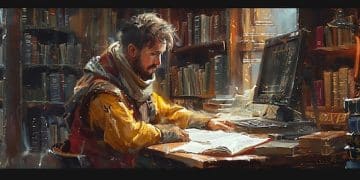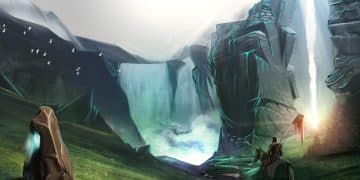Fantasy Worlds Unveiled: Immersive Worldbuilding in Novels
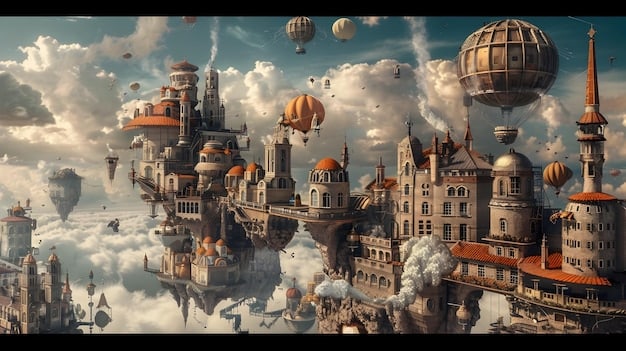
Fantasy worldbuilding captivates readers by crafting intricately detailed, believable realms, enhancing the narrative and emotional resonance of immersive fantasy novels.
The allure of fantasy novels lies not only in their thrilling plots and memorable characters, but also in the intricate worlds they create. Fantasy’s worldbuilding serves as the very foundation upon which these stories are built, captivating readers and offering an escape into realms brimming with magic, history, and breathtaking landscapes. Let’s explore the elements that make a fantasy world truly immersive and examine some of the most successful examples in literature.
The Art of Building Believable Fantasy Worlds
Creating a believable fantasy world is more than just drawing a map and naming some creatures. It’s about crafting a fully realized setting with its own history, culture, magic system, and more. What separates a good fantasy world from a truly immersive one? Authenticity and internal consistency are key; every aspect of the world should feel like it has a reason for being.
Establishing a Rich History
A world’s history shapes its present. Consider the historical context you’re creating: What wars were fought? What empires rose and fell? These events leave their mark on the land, its people, and their customs. Integrating a detailed historical framework adds layers of depth and realism.
Developing Unique Cultures
Culture encapsulates everything from societal norms and traditions to cuisine and art. A well-developed culture gives inhabitants of your world a sense of identity and makes their interactions with each other meaningful. This helps readers connect with the characters and invest in their stories.
- Diverse Belief Systems: Different religions and philosophies can drive conflicts and shape moral codes.
- Intricate Social Structures: Kingdoms, tribes, guilds, and other social groups define power dynamics and relationships.
- Unique Artistic Expressions: Music, art, and literature reflect the culture’s values and aesthetic sensibilities.
The tapestry of cultures woven throughout a fantasy world contributes significantly to its believability and complexity.
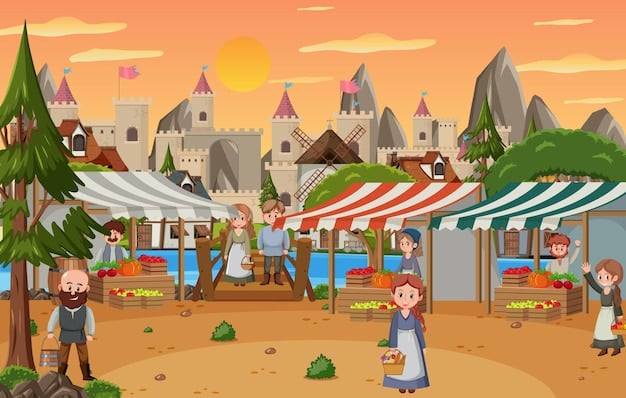
Magic Systems: Defining the Rules of Reality
Magic is a staple of the fantasy genre, but a poorly defined magic system can break immersion. A compelling magic system should have clear rules, limitations, and consequences. The more consistent and logical the magic system, the more believable the world will feel.
Hard vs. Soft Magic Systems
Hard magic systems have well-defined rules, with clear costs and limitations. This allows characters to use magic strategically and predictably. Soft magic systems are more mysterious and less defined, relying on wonder and awe rather than strict rules. Each system has its own strengths, depending on the story you want to tell.
Consequences and Limitations
Magic should never be a “get out of jail free” card. The use of magic should have consequences, whether it’s physical exhaustion, moral corruption, or attracting unwanted attention. Limitations force characters to think creatively and make difficult choices, enhancing the narrative.
- Clear Costs: Magic use should require a sacrifice, whether it’s energy, resources, or something more personal.
- Defined Limitations: Magic should have specific boundaries, such as range, duration, or potency.
- Unintended Consequences: The use of magic should sometimes backfire or create unforeseen problems.
By creating a consistent and believable magic system with defined rules, limitations and consequences, it helps build trust and reinforces the overall immersion.
Geography and Ecology: Shaping the Landscape
The physical environment of a fantasy world is just as important as its history and culture. A well-designed geography should feel realistic, with different regions having distinct climates, resources, and ecosystems. The interaction between environment and inhabitants can lead to unique adaptations and lifestyles.
Realistic Biomes and Climates
A compelling landscape should reflect realistic geological processes and climatic patterns. Deserts, forests, mountains, and oceans should be placed in locations that make sense, and the climate of each region should influence the flora and fauna that inhabit it.
Unique Flora and Fauna
Creating original plants and animals helps to establish the distinctiveness of your world. These creatures should be well-integrated into the ecosystem, playing a role in the food chain and impacting the environment around them.
- Adaptations to the Environment: Plants and animals should have traits that help them survive in their specific habitats.
- Interactions with Inhabitants: The relationship between humans (or other sentient species) and the local wildlife can shape their culture and economy.
- Mythical Creatures: Integrating mythical creatures into the ecosystem adds a layer of wonder and intrigue.
Designing the geography and ecology of your fantasy world thoughtfully enhances its immersiveness and realism, integrating a sense of natural harmony and balance.
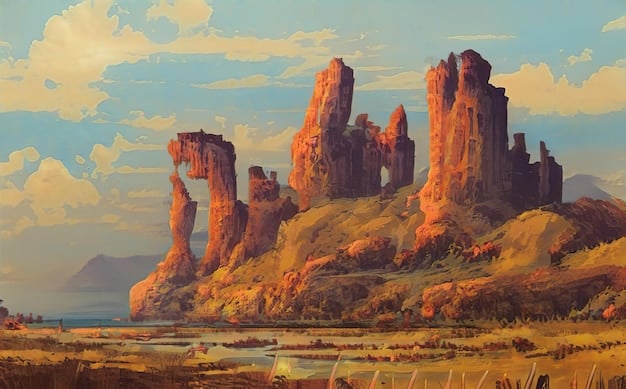
Political Systems and Social Structures
Who holds the power? How is society organized? The answers to these questions shape the political landscape and social dynamics of a fantasy world. Well-developed political systems and social structures add a layer of complexity and realism to the setting.
Forms of Government
Monarchies, republics, theocracies, and other forms of government can influence everything from laws and taxes to social mobility and foreign relations. The strengths and weaknesses of each system can create opportunities for conflict and intrigue.
Social Classes and Hierarchies
The social hierarchy of a world can influence everything from access to resources and education to cultural norms and expectations. Exploring class divisions and power struggles can add depth and complexity to your story.
- Economic Systems: Trade, agriculture, and industry shape the distribution of wealth and the relationships between different groups.
- Legal Systems: Laws and justice dictate acceptable behavior and create consequences for those who break the rules.
- Military Organizations: Armies, navies, and other military forces maintain order and defend the realm from external threats.
By establishing a detailed and internally consistent political system with defined social structures, a fantasy world mirrors the complexities and nuances found in real-world societies, enhancing its credibility and immersiveness.
Language and Communication: A World of Voices
Language is more than just a means of communication; it’s a reflection of culture, history, and identity. Creating unique languages or dialects for your fantasy world can greatly enhance its sense of realism and immersion.
Creating New Languages
Constructing a complete language with its own grammar, vocabulary, and phonology can be a daunting task, but even a few unique words and phrases can add flavor to your world. Consider factors like the culture’s history, environment, and values when designing the language.
Using Dialects and Accents
Different regions and social groups may have their own dialects or accents, reflecting their unique histories and cultures. This can add depth to the characters and make the world feel more diverse.
- Written Scripts: Developing a unique writing system can add another layer of realism and historical depth.
- Slang and Idioms: Informal language and expressions can reflect the culture’s sense of humor, values, and shared experiences.
- Nonverbal Communication: Gestures, body language, and other forms of nonverbal communication can vary between cultures, adding another layer of complexity to interactions.
By developing unique languages or dialects throughout the fantasy novel, reflecting each culture and history, a sense of realism and genuine immersion is emphasized.
Technology and Innovation: Shaping the Future
The level of technology in a fantasy world can greatly influence its culture, economy, and military power. Whether your world is medieval, steampunk, or something entirely unique, the technology should be consistent with the other elements of the setting.
Technological Advancements
Consider the level of technological advancement in your world: What inventions have been made? How widely are they used? The answers to these questions can shape everything from daily life to warfare.
Impact on Society
Technology can have profound effects on society, creating new opportunities and challenges. Exploring the social, economic, and environmental consequences of technological change can add depth and complexity to your story.
- Magical Technology: Combining magic and technology can create unique and innovative devices and systems.
- Resource Availability: The availability of resources like metal, fuel, and magical components can influence technological development.
- Cultural Values: Cultural attitudes towards innovation and technology can shape the direction of technological progress.
Defining what kind of technology exists and where it came from helps develop a more complete and immersive experience for the readers.
| Key Aspect | Brief Description |
|---|---|
| 📜 Rich History | Historical events influence cultures and landscapes. |
| ✨ Magic System | Defines rules, costs, and limits of magic use. |
| 🏞️ Geography | Landscapes shape ecosystems and cultures. |
| 🗣️ Language | Communication reflects culture and history. |
FAQ
▼
An immersive fantasy world integrates consistent internal elements. It must have a developed history, culture, cohesive magic system, and realistic geography. These components should interact plausibly, enriching the world’s authenticity.
▼
History is paramount. Past events, empires, and societal transformations forge the present-day cultural, political, and environmental landscape. Intricate histories provide depth and rationale for current world states and narratives.
▼
Magic systems add intrigue but must be logical. The rules define the magical capabilities, restrictions, and repercussions. Consistent rules prevent deus ex machina situations, making magic feel integrated rather than a convenient plot device.
▼
Geography not only defines locations but also influences environmental conditions, resource availability, and habitat suitability. Climate, terrain, and indigenous plants/wildlife deeply sculpt cultural development and economic activities worldwide.
▼
Unique languages or dialects enhance world depth. A language reflects a culture’s values, history, and relationships. Even few invented words or phrasing conventions can significantly enrich the authenticity and believability of the created realm.
Conclusion
Crafting a truly immersive fantasy world requires attention to detail and a deep understanding of human societies and natural environments. By considering history, culture, magic, geography, and other key elements, you can create a world that feels real, breathes authenticity, and captivates readers for years to come.
